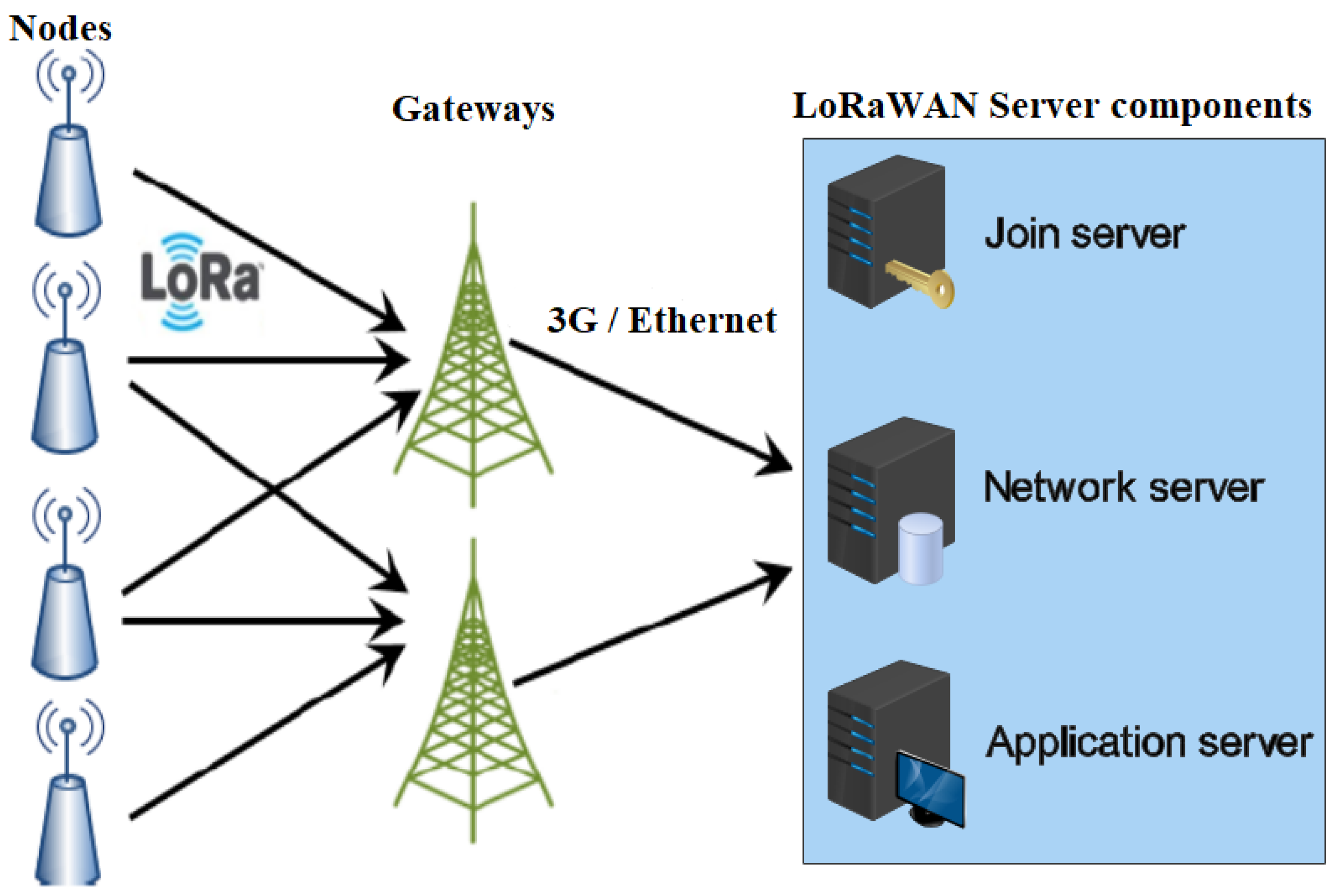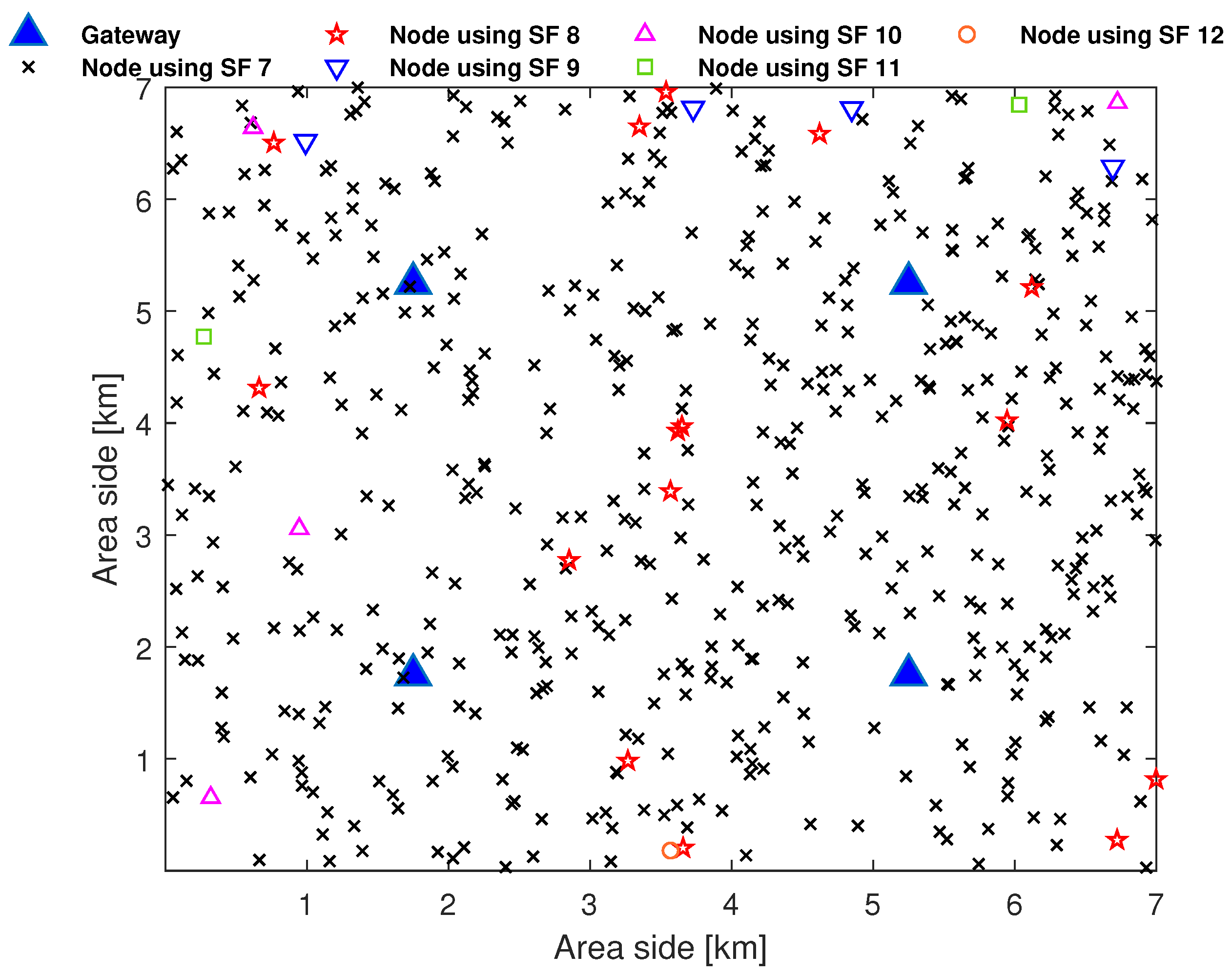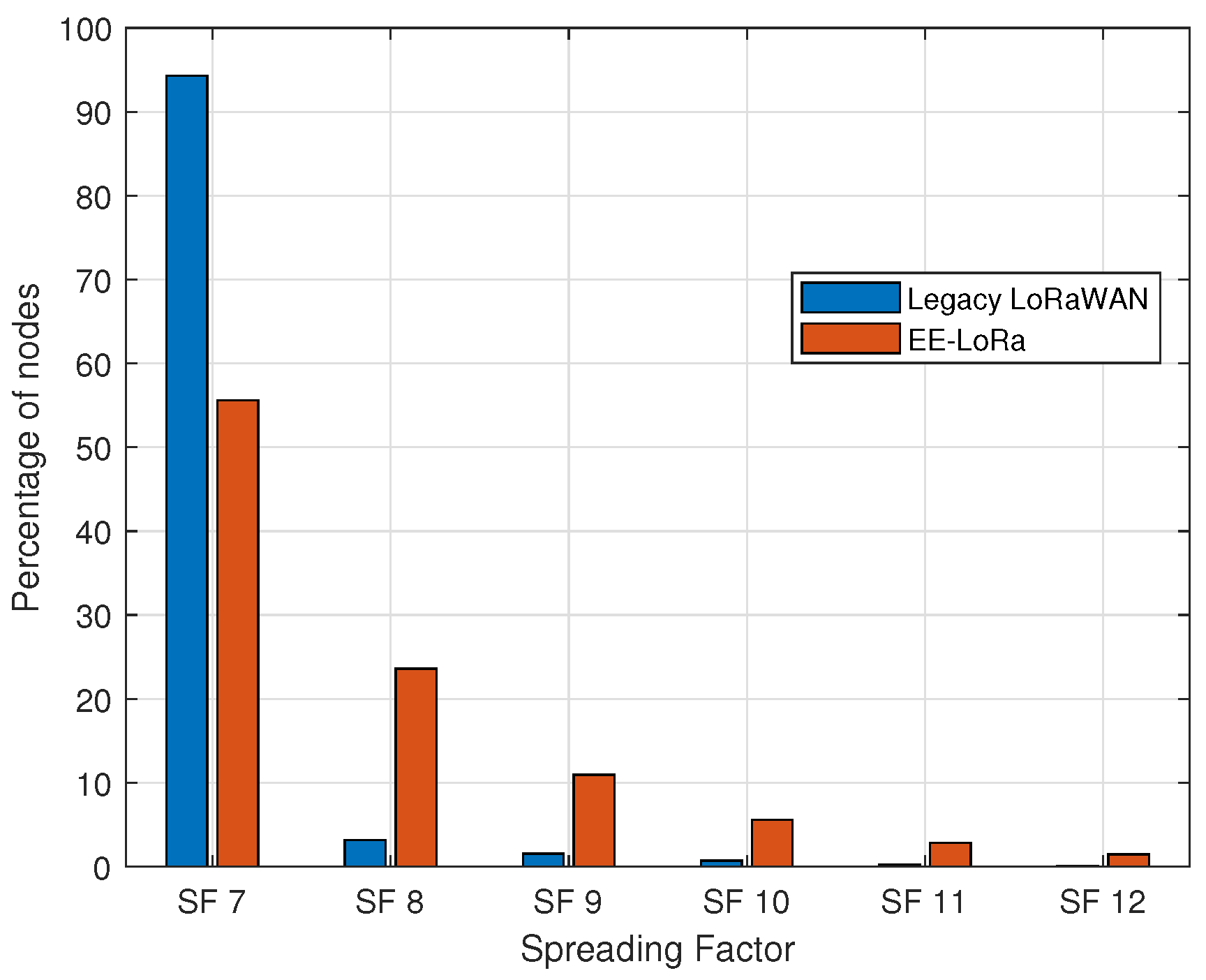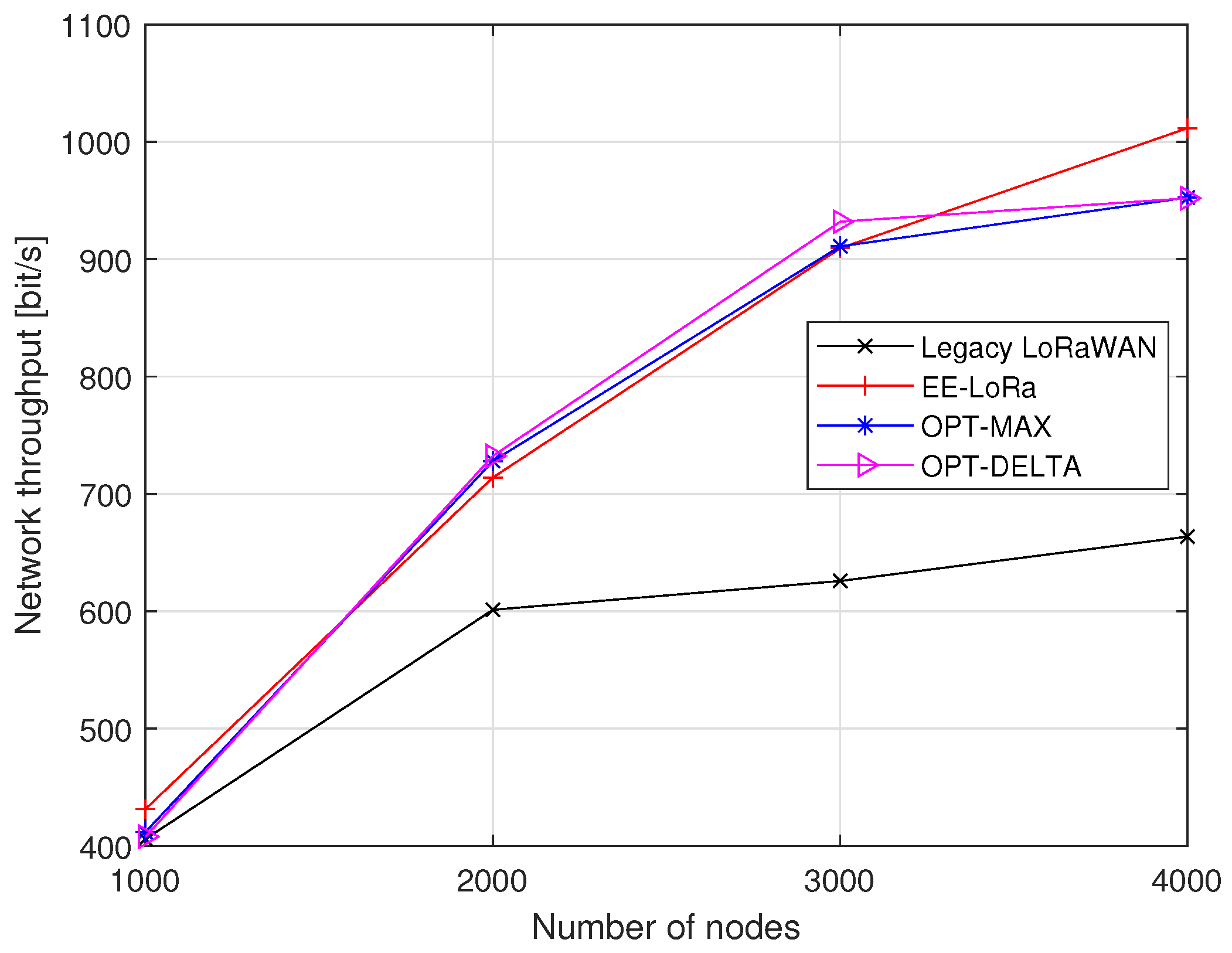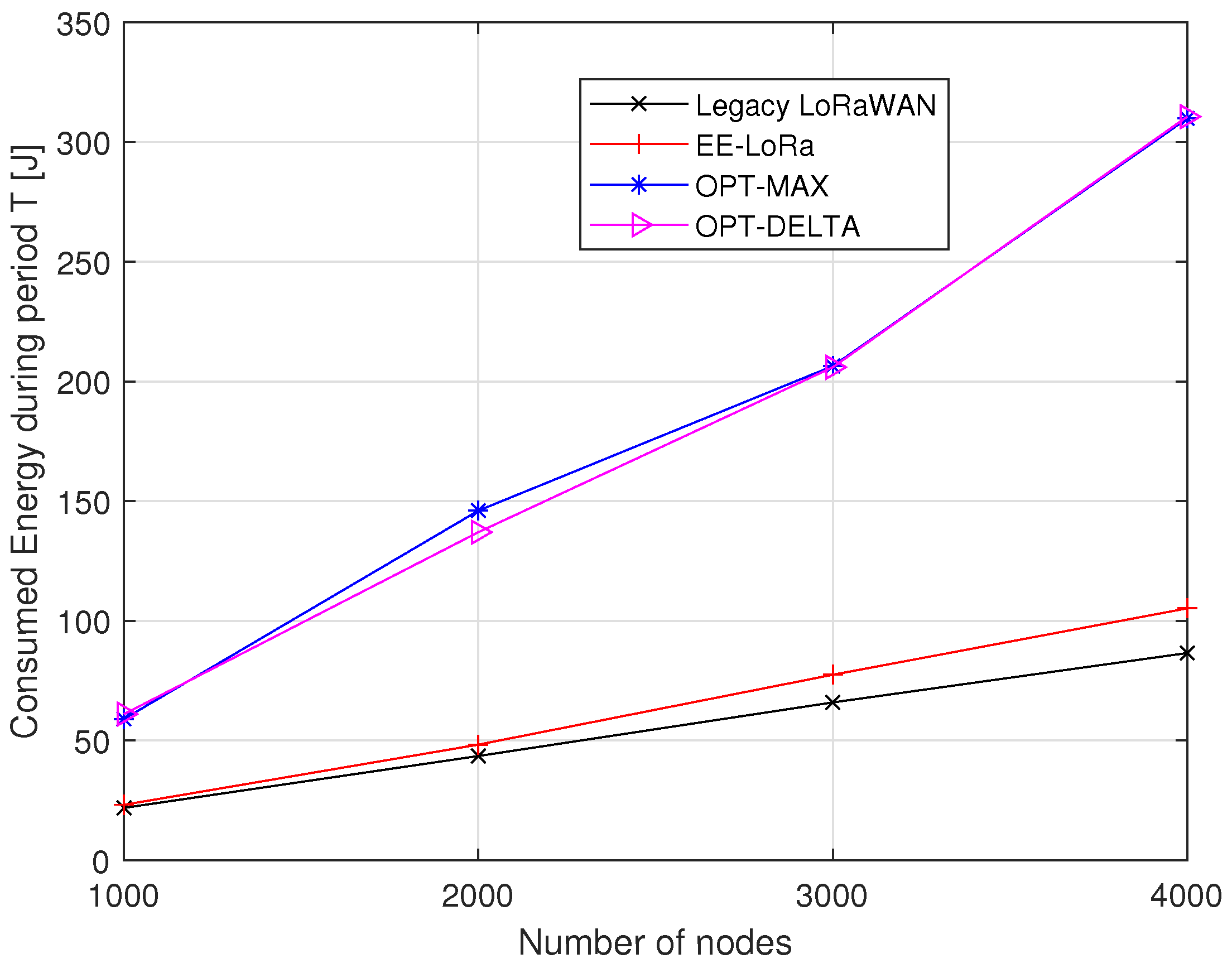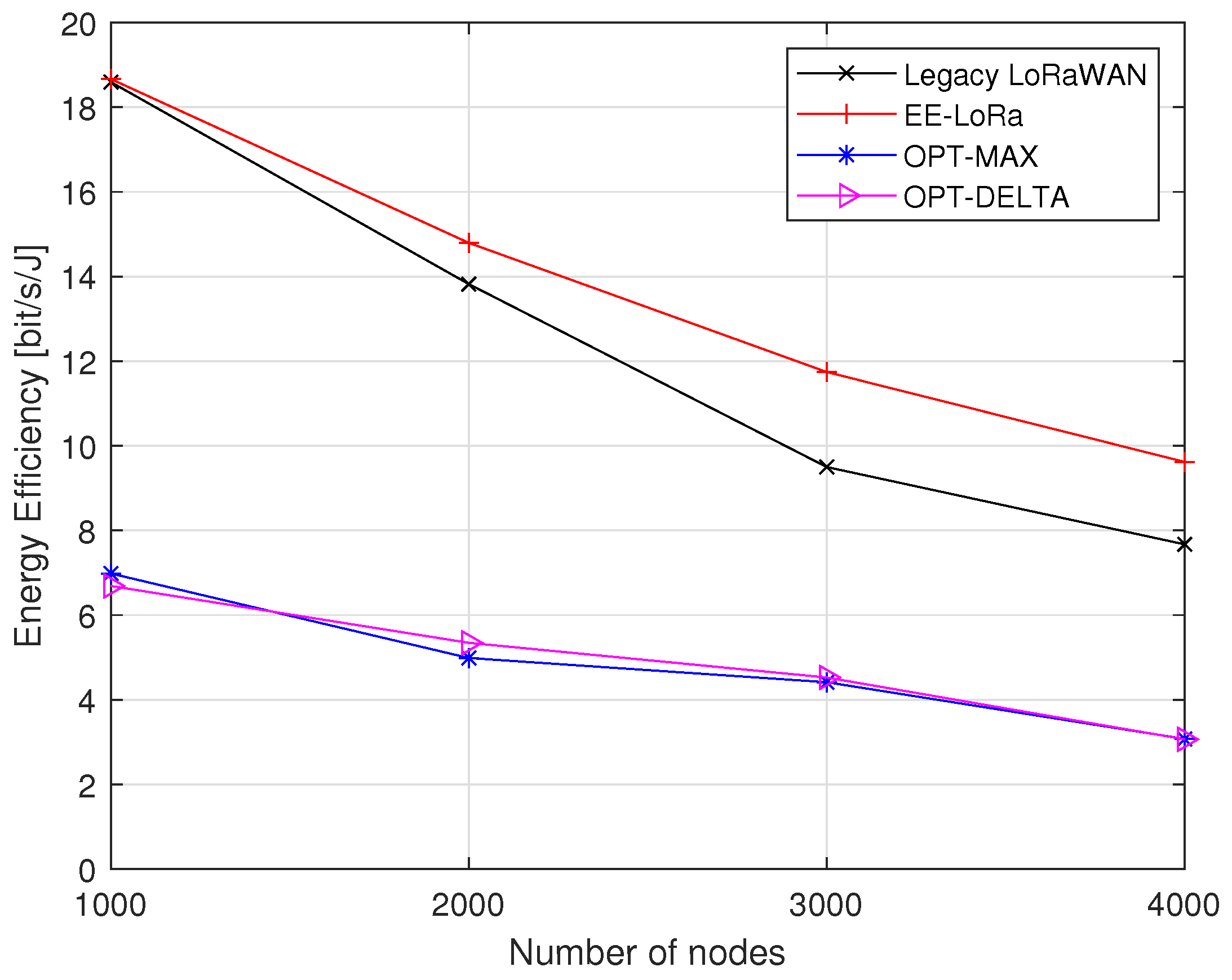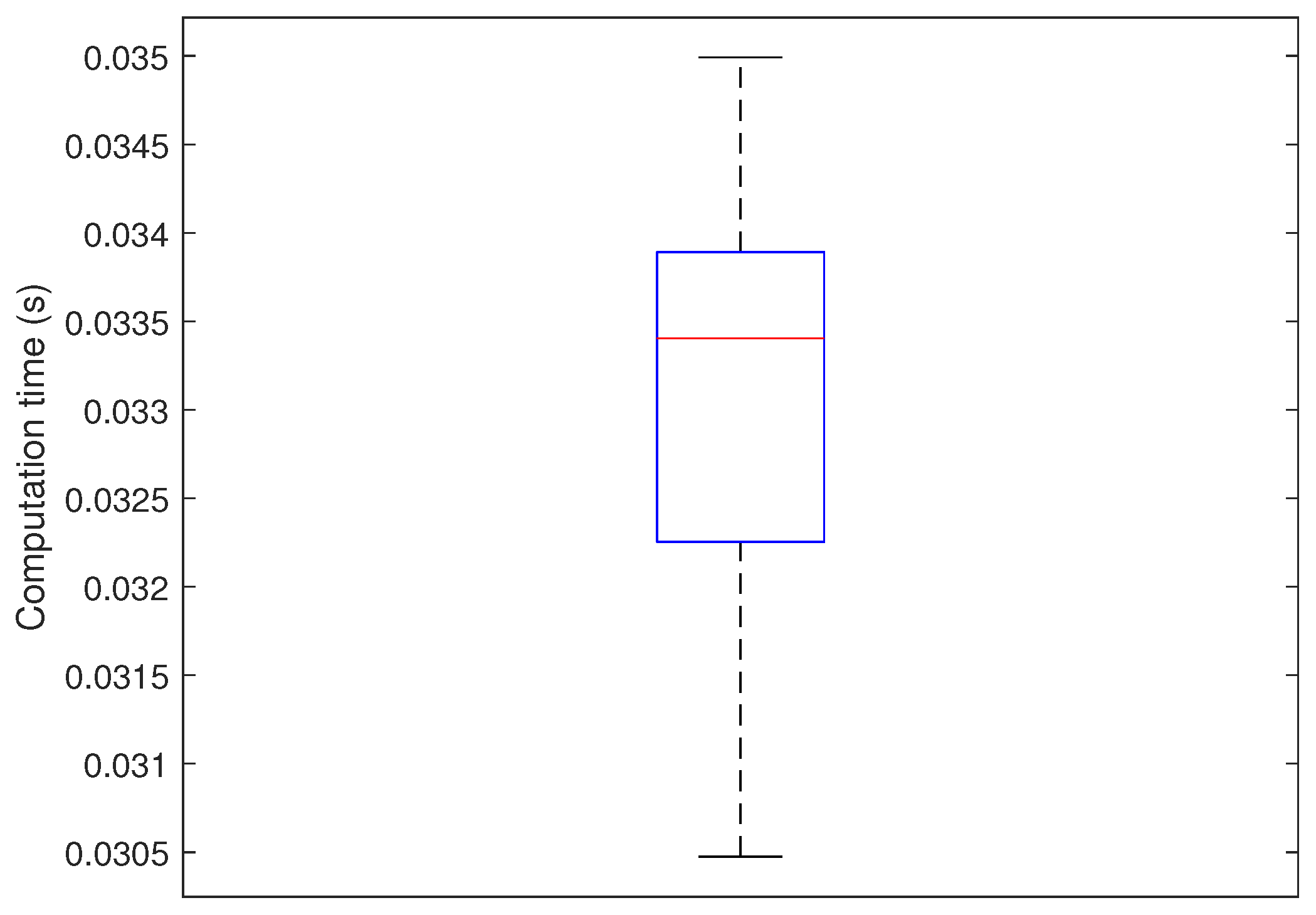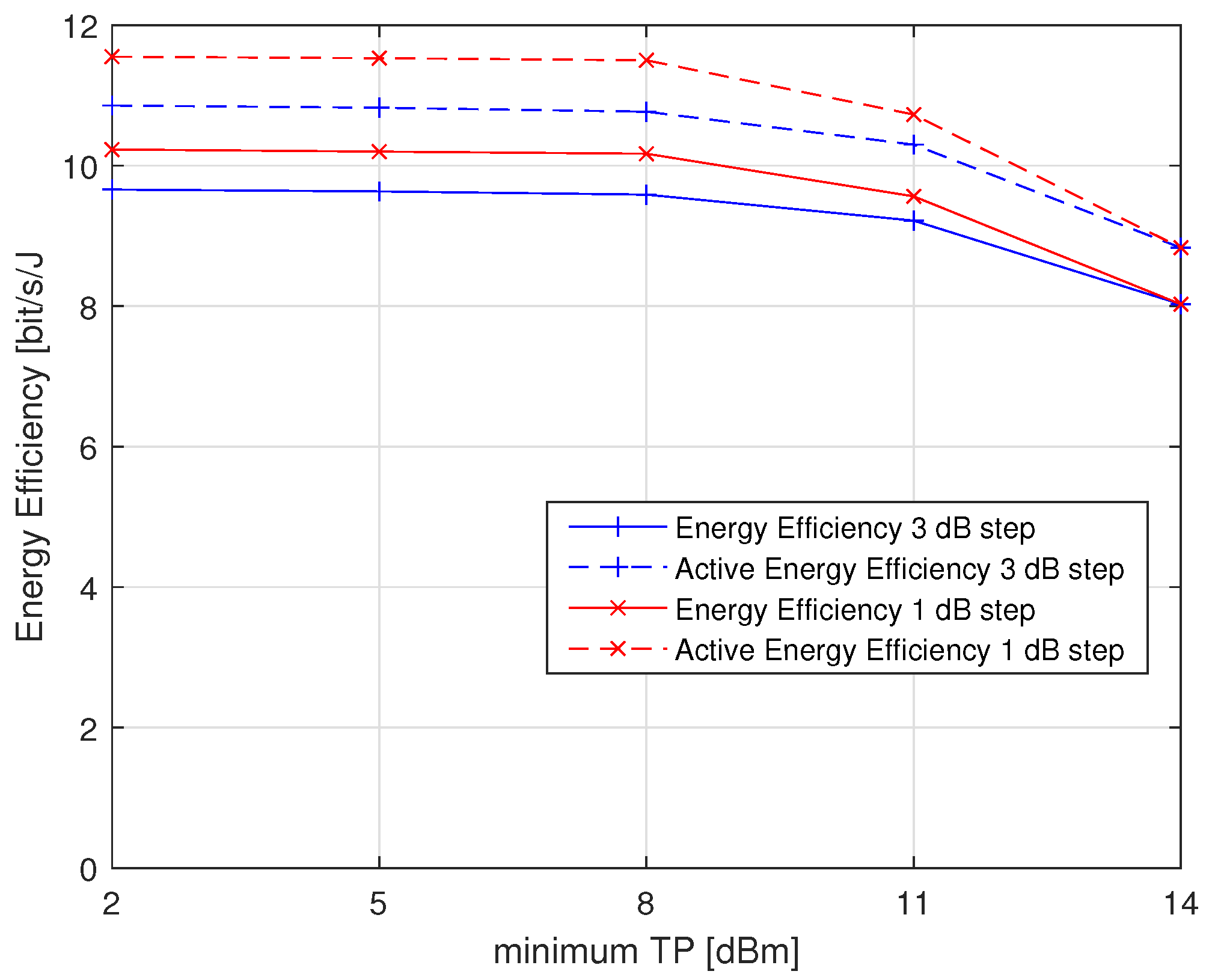1. Introduction
Low-power wide area networks (LPWAN) address the stringent requirements of IoT applications where a massive number of low-cost, power-constrained nodes need to transmit small amounts of data over a long communication range [
1]. LoRaWAN is one of the most widely used LPWAN technologies. Long Range (LoRa) is a wireless communication standard that operates in the unlicensed industrial, scientific, and medical (ISM) band using chirp spread spectrum (CSS) modulation developed by Semtech [
2]. LoRaWAN is the medium access control MAC protocol standardized by the LoRa Alliance that runs on top of the LoRa physical layer. A LoRaWAN network has a star-of-stars architecture consisting of four entities: nodes, gateways, a network server, and an application server. Thus, there is no communication between nodes, and single-hop LoRa communication is used between nodes and gateways. The gateways simply forward the received messages to a central network server over an IP backbone. Precisely, there is no association between nodes and gateways, and a packet sent by a node can be received by multiple gateways. Moreover, the gateways also receive network server acknowledgments (ACK) or MAC commands and send them to the intended nodes. The central network server is in charge of managing network access and functionality, as well as routing messages between nodes and the LoRaWAN application.
The two main configurable parameters in the LoRa physical layer are the spreading factor (SF) and the transmission power (TP). SF refers to the number of bits encoded per symbol. This is the key parameter in LoRa because it affects the time of transmission, data rate, communication range, and power consumption. The greater the SF, the larger the coverage, and the lower the data rate. Lowering the data rate lengthens the transmission time and thus increases power consumption. The nodes closest to a gateway transmit with the lowest SF and highest data rate, thereby extending the battery life. More distant nodes transmit at a higher SF and require a longer time of transmission; therefore, their batteries will be drained quickly. Since SFs are quasi-orthogonal [
3], communication with different SFs on the same frequency channel does not interfere with each other. As for the TPs, these are discrete values depending on the regional regulations [
4]. Using higher TP values extends the communication range at the expense of increased power consumption.
The Aloha access scheme used in LoRaWAN increases the probability of collision and therefore reduces the network throughput, particularly when the density of nodes increases at some SFs. To overcome this problem, some nodes can be reconfigured to use higher SFs. However, this will lead to an increase in power consumption and degrade the energy efficiency of the network. Thus, energy efficiency can be improved by finding the best SF allocation and tuning the TPs of the nodes. In this paper, we introduce EE-LoRa, an algorithm that carefully distributes nodes among different SFs to enhance the energy efficiency of the LoRaWAN network and tunes TPs to the lowest possible levels.
The remainder of this paper is organized as follows. In
Section 2, related work and our contributions are described.
Section 3 presents an overview of LoRa and LoRaWAN technologies.
Section 4 presents the system model. The EE-LoRa algorithm for SF selection and power control to improve the energy efficiency of LoRaWAN networks is described in
Section 4. The simulation setup and obtained results are shown in
Section 6. Finally, we conclude the article in
Section 7.
2. Related Works and Contributions
In LoRa, a collision occurs when multiple nodes send simultaneous messages using the same SF over the same frequency channel. LoRaWAN is based on the Aloha access scheme, where nodes send traffic on a randomly chosen channel. When employing a large number of nodes, such a simple access protocol will increase the probability of collision drastically and therefore reduce the network throughput.
On the one hand, reconfiguring a portion of nodes to use higher SFs can improve the network throughput. On the other hand, this will increase the power consumption at nodes with limited batteries. Thus, improving the energy efficiency in such a network by optimizing the total throughput while minimizing the power consumption of battery-powered nodes at large scales is challenging. Moreover, nodes can save power by reducing the TP to the minimum level that ensures the reliability of communications. Consequently, the energy efficiency can be improved using a suitable algorithm that tunes both SF and TP to keep pace with the pervasive green trend in networking.
LoRaWAN introduced the adaptive data rate (ADR), a simple mechanism that aims to dynamically adjust the data rate at every node based on its link budget [
5]. However, such an algorithm needs a long convergence time (hours to days). It is suitable only for stationary or slow-moving nodes with stable radio conditions [
6]. In addition, it manages the transmission parameters at each node individually without considering the overall network performance. There are many recent studies for resource allocation to enhance the ADR scheme in dense LoRaWAN networks. A comparative study of the proposed solutions was presented in [
7,
8,
9]. Some of them employ stochastic geometry, where SF selection is based on the distance between the node and the gateway [
6,
10,
11]. However, such algorithms are limited to single-gateway scenarios. In addition, the link budget can differ for nodes the same distance from the gateway, especially in cities. Many other algorithms with different objectives were proposed to optimize LoRaWAN networks by configuring one or more LoRa resources (SF, TP, channel). A summary of recently proposed algorithms is given in
Table 1.
The authors of [
12] proposed an SF-selection algorithm that aims to maximize the minimum packet reception probability for all nodes considering energy consumption using a distributed genetic algorithm. An optimization problem for SF selection was devised in [
13] in order to maximize the network throughput in multi-gateway scenarios. To achieve the optimal SF distribution, an adaptive algorithm that adjusts the signal-to-noise ratio (SNR) thresholds was developed. A heuristic algorithm for SF assignment named AD MAIORA was presented in [
14]. The authors intended to decrease the load that some nodes put on some gateways by selecting a given SF. In multi-gateway scenarios, they iteratively found the best SF for each node. The authors of [
15] proposed FADR, an SF-selection and TP-control algorithm for single-gateway deployment, to achieve an equal collision probability among different SFs while avoiding overly high TPs to reduce the energy consumption.
An MILP was formulated in [
17] to derive the optimal SF and CF settings, considering the network traffic specifications, to reduce collisions and energy consumption in LoRaWAN networks. They evaluated the effectiveness of their approach in a single-gateway scenario. Compared to ADR, they improved the DER by 6% while reducing the network energy consumption.
The authors of [
18] suggested a modified version of the MAC protocol LoRaWAN called LoRa+ for classes A and B consisting of receiving new channel parameters by nodes just before transmission. They showed that their approach decreased the packet error rate by up to 20% compared to legacy LoRaWAN when the number of nodes was less than 500.
The authors of [
16] devise optimization problems to derive the optimal configuration at each node to improve reliability and minimize power consumption in dense LoRaWAN deployment. Since the proposed problems are nonlinear, they were transformed into integer linear programming (ILP) models and solved using IBM CPLEX. A two-stage optimization process was introduced to improve the delivery ratio and minimize the energy consumption in networks with multiple gateways. In the first stage, all nodes are assumed to use the highest TP. They proposed two approaches to assign SF to each node. The first, named OPT-MAX, aims to minimize the maximum probability of collision at each SF, like [
20]. The second, named OPT-DELTA, derives the SF for all nodes in a way to balance the probability of collisions in all SFs. Once the SFs for all nodes are assigned, they apply the power-control stage, OPT-TP, to minimize the energy consumption of all nodes. They showed that their proposed solution outperforms the packet delivery ratio (PDR) by up to 8% compared to the state of the art with minimal energy consumption. However, the complexity of ILP is high and it requires a long computation time, which increases exponentially with the number of nodes.
The authors of [
19] suggested a low-power multi-armed bandit (LP-MAB) mechanism, a centralized adaptive LoRaWAN configuration scheme. They intended to improve the PDR while reducing energy consumption. They used exponential weights for exploration and exploitation (EXP3), as well as the successive elimination (SE) methodology, to combine non-stationary adversarial and stochastic methods. They configured the transmission parameters of nodes centrally on the network server. The network server tries to learn the optimal set of transmission parameters for each node based on the reward, which is dependent on the receipt of acknowledgment messages.
The studies in [
12,
15,
17] are limited to single-gateway deployments, whereas the studies in [
12,
13,
14,
17,
18] lack a power-control strategy. In contrast to [
19], whose method is focused on acknowledgment messages delivered from the network server, we focus our research on class A with unconfirmed transmission mode, where nodes do not request an acknowledgment from the network server after each transmission. Contrary to the work in [
14,
16], we do not consider the load of nodes at the gateway level, which requires more complicated calculations and a longer computation time. However, we concentrate on improving the overall network’s energy efficiency by extending its lifetime and increasing the throughput with our EE-LoRa algorithm. Moreover, after allocating the SFs and TPs of each node, we implicitly redistribute the load across the various gateways.
We summarize the major contributions of our work as follows:
We propose a novel algorithm, named EE-LoRa, to improve the energy efficiency of LoRaWAN networks with multiple gateways. We devise an optimization problem that maximizes the energy efficiency of the network, defined as a benefit-cost ratio between the network throughput and the consumed energy.
We use in our optimization problem a precise model of energy consumption that considers different modes of the class A LoRa transceiver over a period of time between two successive transmissions.
We prove the convexity of our problem, and we use the Dinkelbach iterative method, where convergence is rapidly attained.
Our algorithm, EE-LoRa, does not require signaling (beacons) or an additional synchronization process. It does not introduce any change to the LoRaWAN specification and can be applied to all LoRaWAN classes, particularly class A. Actually, the network server only sends downlink notifications to nodes that should change their configurable parameters (SF, TP) in one of their receiving windows.
We evaluate our algorithm in a realistic scenario and compare the results to legacy LoRaWAN and relevant state-of-the-art algorithms, namely, OPT-MAX and OPT-DELTA. Moreover, we assess the results in different contexts related to minimum TP and idle current. We demonstrate that EE-LoRa outperforms the energy efficiency of legacy LoRaWAN and relevant state-of-the-art algorithms.
3. LoRa and LoRaWAN Overview
This section presents the aspects of LoRa and LoRaWAN technologies that are relevant to our work.
LoRa is a physical-layer technology developed by the Semtech corporation [
2]. It modulates signals using a CSS technique that spreads a narrow-band signal over a wider channel bandwidth (BW). It supports multiple frequency channels (e.g., on the 433, 868, or 915 MHz ISM bands) depending on the region in which it is deployed [
4]. This technique makes the signal robust to interference due to the processing gain of the spread-spectrum technique. As a result, the maximum power budget for LoRa operating in the 868 MHz band can exceed 150 dB (the receiver can decode transmissions 19.5 dB below the noise floor), thus enabling long communication ranges.
LoRa is characterized by various configurable parameters affecting the throughput, power consumption, and communication range, as detailed below.
Carrier Frequency (CF): Represents the central frequency used in a band. LoRa operates in the unlicensed sub-GHZ ISM band, and the CF can be programmed within the range of 137 MHz to 1020 MHz in steps of 61 Hz. Specifically, the CF varies according to geographical regions, such as 868 MHz in Europe, 433 MHz in Asia, and 915 MHz in America. LoRa nodes typically support sixteen channels, while gateways usually support eight channels. In Europe, networks operate in the EU863–870 ISM band, which allows up to eight channels with a 125 kHz bandwidth each. Moreover, the three following channels (868.1, 868.3, and 868.5 MHz) are mandatory [
4].
Spreading Factor (SF): Refers to the number of bits encoded per symbol. This is the key parameter in LoRa because it affects the time of transmission, data rate, communication range, and power consumption. LoRa supports multiple SFs ranging from seven to 12.
Table 2 gives the variation of the data rate, sensitivity, and SNR thresholds of different SFs for the 868 MHz band. Note that for SNR values lower than −20 dB, a node is considered out of network coverage. Going from SF 7 to SF 12 decreases the receiver’s sensitivity from −123 dBm to −137 dBm and, therefore, extends the coverage. However, this comes at the expense of lowering the data rate and increasing the transmission time and energy consumption. The throughput limitation in LoRa can be seen from
Table 2, where the data rate varies between 0.3 (using the highest SF 12) and 5.4 kbps (using the lowest SF 7). We note also that the different SFs are quasi-orthogonal [
3], which enables the simultaneous reception of packets with different SFs.
Bandwidth (BW): Defines the spectrum occupied by a symbol. It can be set to 125, 250, or 500 kHz. A larger bandwidth corresponds to higher data, at the expense of reducing sensitivity.
Coding Rate (CR): LoRa uses a forward error correction (FEC) scheme to perform error detection and correction by adding redundancy bits, improving the robustness of the transmitted signal. The coding rate can be set to with CR values ranging from 1 to 4. Increasing the CR value gives more protection against interference. However, this will increase the transmission time and power consumption.
Transmission Power (TP): It can be adjusted from −4 dBm to 20 dBm in 1 dB steps. Due to hardware implementation limitations, the range frequently varies from 2 dBm to 20 dBm. The highest TP is subject to regional regularity constraints, e.g., 14 dBm in Europe [
4]. Using higher TP values extends the communication range at the expense of increased power consumption.
Table 2.
Data rate, sensitivity and SNR thresholds of different SFs for the 868 MHz band, bandwidth 125 kHz, coding rate 4/5 [
21].
Table 2.
Data rate, sensitivity and SNR thresholds of different SFs for the 868 MHz band, bandwidth 125 kHz, coding rate 4/5 [
21].
| SF | Data Rate [kbps] | Sensitivity [dBm] | Required SNR [dB] |
|---|
| 7 | 5.458 | −123 | −7.5 |
| 8 | 3.125 | −126 | −10 |
| 9 | 1.757 | −129 | −12.5 |
| 10 | 0.976 | −132 | −15 |
| 11 | 0.537 | −134.5 | −17.5 |
| 12 | 0.293 | −137 | −20 |
A LoRa symbol (chirp) is made up of
chips in which the chip rate equals the BW. For example, SF 9 means that each chirp consists of
RF chips carrying nine data bits. The symbol duration can be expressed according to the following formula [
2]:
Thus, the symbol rate
(symbols/s) can be deduced as follows:
Having a code rate
, we can express the data rate (
) in bits/s as follows [
20]:
The frame structure at the physical layer comprises a preamble, an optional header, and the data payload, as shown in
Figure 1. The preamble allows the receiver to be synchronized with the transmitter. The preamble contains a number of
up chirp symbols with 4.25 LoRa symbols as frame delimiters for synchronization. As a result, the preamble length is equal to (
) symbols. Thus, the preamble duration can be expressed as follows:
Because the preamble size scales with SF and there is no single preamble for all SFs, the transmitter and receiver must know the SF in advance in order to detect the preamble. There is an optional PHY header following the preamble. This header is transmitted with the highest code rate of 4/8 when it is present. The remaining portion of the frame is encoded using the code rate specified in the PHY header. The payload is sent after the header. The maximum payload size is defined for each region in the LoRaWAN Regional Parameters [
4]. For the EU863-870MHz band, the maximum payload size varies between 51 bytes for the slowest data rate (SF 12, BW 125 kHz) and 222 bytes for the faster rate (SF 7, BW 125 kHz). There is an optional payload CRC at the end of the frame.
The number of symbols
that comprise the header and the packet payload is calculated with Equation (
5). We denote by
the size of the payload in bytes;
H is equal to 0 when the header is enabled and 1 otherwise; and
if low-data-rate optimization is enabled (
), and 0 otherwise [
2].
Then, we can deduce the payload duration as follows:
The time on air (ToA) of a LoRa transmission is computed according to the payload size and depends on several parameters: SF, BW, and CR. These parameters can cause significant variation in the transmission time. The time on air is simply obtained as the sum of the preamble and payload duration: for a given payload size, and at a given BW and coding rate, we denote by
the time to transmit a packet at SF
s.
Table 3 presents the ToA configuration assuming a 125 kHz bandwidth and a coding rate of 4/5. It can be seen that the ToA increases when the SF is incremented.
On top of the physical layer runs the medium access control MAC protocol, LoRaWAN, standardized by the LoRa Alliance [
5]. This open-access standard describes the network architecture and defines the communication protocol used to connect each network entity. LoRaWAN is designed as a single-hop star network. While this greatly simplifies the deployment and operation, it also implies that enough gateways should be available to cover the deployment area.
A LoRaWAN network has a star-of-stars topology, as illustrated in
Figure 2. It is made up of the following entities [
5]:
Nodes: They are also known as end-devices or motes. Each node contains basically a microcontroller, a radio unit, and other peripherals such as sensors, and only transmits data to gateways using single-hop LoRa communication.
Gateways: They are made up of a LoRa transceiver chip and a baseband processor. They can decode multiple channels simultaneously and support between eight and 64 channels. They simply relay received messages to a central network server via an IP backbone. The IP traffic from a gateway to the network server can be via Wi-Fi, hardwired Ethernet, or a cellular connection. The packet forwarder specifies the protocol used to communicate with the network server. There are various packet forwarders; the two most popular ones are the Semtech User Datagram Protocol (UDP) and Message Queuing Telemetry Transport (MQTT) [
22]. The majority of LoRa gateways still come pre-compiled with the Semtech UDP forwarder, which was the original packet forwarder. Gateways also receive network server acknowledgments (ACK) or MAC commands and send them to the intended nodes. Note that there is no association between nodes and gateways, and a packet sent by a node can be received by multiple gateways.
LoRaWAN Server: Consists of a central network server, an application server, and a join server. The LoRAWAN specification treats these servers as if they are always co-located. The network server is the center of the star architecture. It manages network access and functionality and is responsible for routing messages between nodes and LoRaWAN application. It handles node authentication and authorization, data transmission, data rate adaptation, and duplicate packet elimination. The application server processes all data messages received from nodes. Moreover, it generates and sends all application-layer downlink payloads to connected nodes via the network server. Several applications can be connected to a single network server. The join server is in charge of managing the over-the-air (OTA) node-activation procedure. It sends the node’s network session key to the network server and the application session key to the appropriate application server.
Figure 2.
LoRaWAN architecture.
Figure 2.
LoRaWAN architecture.
When a node sends a message to the gateway, it is referred to as an uplink, whereas when the gateway sends a data packet to the node, it is known as a downlink. Furthermore, there are two types of messages in any LoRaWAN operation: (1) unconfirmed messages, in which the nodes do not request a response from the network server, and (2) confirmed messages, in which the nodes do request a response from the network serer.
LoRaWAN defines three different classes of nodes with different capabilities and power requirements, as illustrated in
Figure 3. Class A supports basic bidirectional communications; two receive windows RX1 and RX2 will be opened after RECEIVE_DELAY1 and RECEIVE_DELAY2, respectively, from transmitting uplink messages. During these two receive windows, the network server can send acknowledgment and MAC commands to nodes so as to control transmission parameters such as the spreading factor, power, and bandwidth. RX1 uses the same SF as the original uplink, while RX2 uses SF 12 and is opened only if the downlink message is not received during RX1. Class A implementation is required for all devices when nodes send sporadic data to gateways through an Aloha-based access mechanism. Class A nodes spend most of their time in the sleep state and consume the least energy. Class B extends Class A by adding extra receive windows at scheduled times. The nodes are synchronized by the periodic broadcast of beacons from gateways. Finally, nodes of Class C are permanently listening to the channel with continuously open reception windows.
